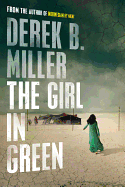
In his Scandinavian-set debut, Norwegian by Night, Derek B. Miller introduced readers to an elderly Korean War veteran finding his place in the modern world. In his sophomore novel, The Girl in Green, international affairs specialist Miller takes a giant step out of Norway to follow two unlikely heroes on an errand of mercy in one of the most dangerous places on Earth--modern-day Iraq, where the label "postwar" clashes with the reality of life for its citizens. As daring in execution as imagination, this adventure tale crackles with heart, charm and dark honesty.
During the uneasy ceasefire following the first Gulf War in 1991, an American soldier in his early 20s named Arwood Hobbes meets Thomas Benton, an older British journalist, in the midst of the "industrial and inescapable" boredom at his post 150 miles from the Kuwaiti border. As Arwood's superior officer explains with logic somewhat reminiscent of Heller's Catch-22, "[t]he State Department believes if we help these people now, they will hate us later," so the soldiers have nothing to do. Cocky and determined to get a local perspective on the Shiite rebellion, Benton takes Arwood's semi-dare to sneak over to a nearby town to interview Iraqis. When violence strikes and Arwood steps in to rescue Benton, the two find themselves trying to save a Kurdish girl in a green dress, but are unable to stop the teen's murder at the hands of a Ba'athist colonel. Arwood and Benton both lose a part of themselves when the girl dies. As Arwood says, "I think I have pretraumatic stress disorder. I'm stressed out from not being able to do the right thing." While the younger man receives an other-than-honorable discharge for assaulting the commanding officer who failed to support him in the standoff over the girl, Benton takes the quieter approach of going on with his life, but drifts emotionally from his wife and young daughter.
Twenty-two years later, Benton hears from an agitated Arwood, who believes he just saw the girl in green, un-aged and in the same dress, in an Internet video of a mortar attack on refugees in Kurdistan. After a show of token resistance, Benton agrees to meet in a refugee camp in Dohuk. He knows the girl in green died of a gunshot wound in 1991, and that the lookalike in the video must surely have died in the bombing, but Arwood's argument that the universe has granted them a chance to right a terrible wrong compels him nonetheless. However, he quickly finds that Arwood, always a wild card, has grown into an enigma who never tells the entire truth, lives by his own moral code, and could possibly be quite insane.
With the help of Swedish humanitarian worker Märta, the pair set off into the desert to find a girl who, in their minds, exists as both dead and alive and who might save them--if they save her first. The mystery of who and what Arwood Hobbes has become--criminal, hero, madman--baffles Benton as he quickly realizes his partner hasn't shared the whole plan. When Arwood's quixotic mission lands the men and two innocent bystanders in the hands of ISIL, they will need the skills and connections of every ally they have, plus a measure of blind luck, to survive. Attempting their rescue is a diverse secondary cast including refugees, NGO workers, international helicopter pilots and strong female characters including Benton's now-grown daughter, Charlotte, whose attempts to locate her father and talk some sense into him connect her with an adorably overconfident aid worker named Miguel.
Miller pulls off an amazing feat of alchemy here, because this chronicle of trauma, violence and endless conflict is the unlikely feel-good story of the year. Not only does he pepper the narrative with enough absurdist humor and one-liners to keep readers helplessly grinning at the darkest moments, he hits points of emotional resonance with the precision of a sniper. Miller understands the story readers most need, the great welling of satisfaction that comes from watching two off-kilter heroes burst messily through walls of red tape, armed men and cultural boundaries to save one innocent stranger. Arwood and Benton's is a story filled with human motivations like saving a life, healing a hurt, and the deceptively simple desire to do the right thing fueled by a moral statement straight out of Horton Hears a Who: "...a person's a person no matter how small, right?" Miller's style is an all-terrain vehicle, though, and he knows when to switch gears, skillfully exploring the moral implications and ambiguities of war while avoiding partisan politics and armchair quarterbacking.
In Arwood and Benton, readers will see the kind of big personalities that carry movie franchises. Whether our heroes are wondering where they went wrong (usually Benton), or introducing a new half-baked plan sure to save the day unless it gets them killed (usually Arwood), just going along for the ride would be entertaining enough, but Miller also provides ample food for thought and an ending that roars. A word of advice: buy The Girl in Green rather than borrow it. With the proliferation of sharp one liners, occasional droplets of poetry like "the buzuq sings a song for which there will never be any words," and insightful distillations of the intricacies and contradictions of an American conflict that slides from phase to phase without ever ending, the urge to highlight and dog-ear will overcome even the most book-proud reader. --Jaclyn Fulwood

